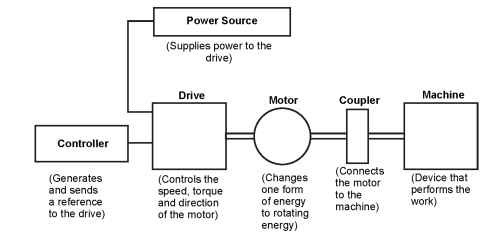At this point, we will look at a variable-speed drive system—from a generic standpoint. All drive systems, whether, electronic, mechanical, or fluid in nature, have the basic parts indicated in Figure 1-6.

Figure 1-6. Generic variable-speed drive system
To understand a simple drive system, we will start at the end of the system and move backward. We will devote individual sections of this topic to each of the basic components listed in Figure 1-6. For now, the intent is to develop a basic understanding of a drive system. A foundation will be built, which will allow more complex concepts to be discussed in later topics.
Machine
The essence of any drive system is the application, or machine. This is the heart of the system, since it ultimately needs to perform the work. Consider the machine—the application. It could be a conveyor, a press, a packaging machine, or literally hundreds of applications that operate at variable speed.
Coupler
The coupler is the device that connects the machine to the motor. Couplers come in all shapes and sizes. Its basic task is to make a solid connection between the motor and the machine. Couplers may accept one diameter of motor shaft and convert the output to another size shaft. In
some cases, the coupler may actually be a device called a gearbox, which may include some type of speed-reducing or speed-increasing gears. Couplers could also be considered matching devices because of their ability to deliver power smoothly to the machine. To a certain extent, this device can also cushion shocks delivered by the motor to the machine.
Motor
This device changes one form of energy to rotating mechanical energy. It can be considered the prime mover because it takes power from the drive unit and translates it into motion. As we will see shortly, there are several types of motors using various forms of energy. In this topic, we will discuss mechanical, hydraulic, AC, and DC motors. The size of the motor usually dictates the amount of rotating motion it can generate from incoming power. We will see later that there are a few exceptions to this principle.
Drive
The drive can be considered the heart of the whole system. This section controls the speed, torque, direction, and resulting horsepower of the motor. The drive is very similar in nature to an automobile drive system. The transmission and drive shaft controls the speed, direction, and power delivered to the wheels. Much of this topic will be devoted to AC and DC drives. However, we will take a brief look at other types of drive systems that exist in industry.
Power Source
The drive must have a source of power to operate effectively. If the drive is electrical, it must have either single- or three-phase power available. The drive then accepts this power and modifies it to an output that is usable by the motor. If the drive is hydraulic, the power source could be considered the hydraulic-fluid reservoir, since it supplies the drive with the form of power it needs to accomplish the job.
Controller
The controller supplies a reference signal to the drive unit. Typically controllers are electronic and supply a small voltage or current signal to the drive. The larger the signal, the more power the drive generates, and the faster the motor rotates. In many cases, the controller is an automatic device such as a computer. The computer has the ability to take in signals from external devices such as switches or sensors. The controller then processes the signals, does calculations based on the sensor inputs, and generates a reference signal. This output reference signal is usually a speed signal to tell the drive how much power to generate. As we will see in later topics, this is not always the case. The controller could generate an output signal to tell the drive how much power to generate in order to control motor torque or motor shaft position. The operator station in Figure 1-5 can also be considered a controller. Instead of being an automatic device, the operator station provides a signal based on a manually operated switch or speed control set by a human operator.
